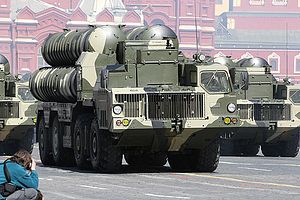Iran has deployed an unknown number of S-300PMU-2 Favorite long-range surface-to-air missile (SAM) batteries around the Fordow nuclear site located 100 kilometers (60 miles) south of Tehran, Iranian state media reported on August 29.
The underground nuclear facility is located 90 meters under a mountain and has not enriched any uranium since the signing of the so-called Joint Comprehensive Plan of Action (JCPOA), an international agreement on the nuclear program of Iran signed in July 2015.
“Our main priority is to protect Iran’s nuclear facilities under any circumstances,” Brigadier General Farzad Esmaili, commander of the Islamic Revolutionary Guards Corps’ (IRGC) air defense force, told state TV. “Today, Iran’s sky is one of the most secure in the Middle East.”
The footage shown on television shows a number of trucks carrying at least eight missile launch tubes, one transporter erector launcher, and a 64N6E2 detection radar unit. From the footage, however, it is impossible to verify independently whether the the missiles have indeed been deployed near the Fordow nuclear site.
It is also still unclear what type of missile Russia has supplied to Iran for the S-300PMU-2 Favorite long-range air defense system. Next to a number of shorter range missiles, the S-300 batteries are usually armed with the 48N6E, a vertical tube launched, solid fuel, single stage SAM with an estimated range of 150 kilometers (93 miles). The S-300 air defense systems could also be equipped with an upgraded variant of the 48N6E, as I explained elsewhere (See: “Russia Delivers First Missiles for Iran’s New Air Defense System”):
In comparison to the S-300-PMU1 system, the upgraded PMU2 variant can engage both short-range ballistic missiles as well as medium-range tactical ballistic missiles. With the new 48N6E2 missile, the effective range of the SAM complex extends to about 195 kilometers (121 miles). (…) Some analysts believe that the 48N6E2 missile is compatible with older S-300 SAM systems.
So far, it is has only been confirmed that one S-300 battalion has been delivered to Iran. Several more “S-300 battalion sets” are expected to be delivered by the end of 2016, according to a Russian official. As I explained elsewhere:
One S-300 battery usually consists of an engagement radar, a low-altitude radar, and up to eight transporter erector launchers (TEL) with four launch tubes each. Each tube carries one surface-to-air missile. A battalion can comprise four to six batteries in addition to a command/fire and control post, as well as an extra target acquisition radar unit.
In May, Iran announced that it had inducted an unknown number of S-300 batteries into its Khatam al-Anbia Air Defense Base, a military branch controlling all of Iran’s land-based air defenses.































